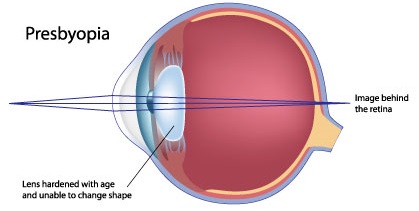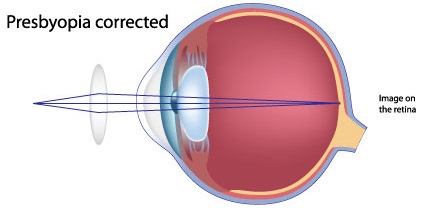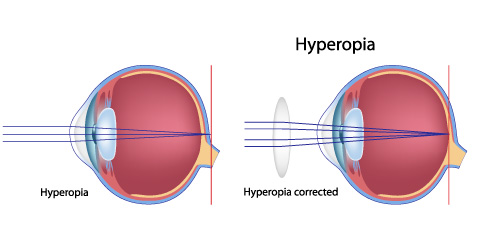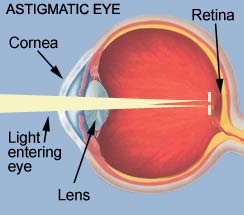Common Eye Disorders and Fixes
Four common eye disorders are presbyopia,
hyperonia, myopia, and astigmatism. These
disorders are caused by the eye not refracting light
properly.
Presbyopia
The eye has has the ability to see closer
objects due to the process of accommodation.
However this ability deteriorates as the eye ages,
since the lens becomes less flexible. So instead
of being able to adjust the focal length with
the ciliary muscles the focal point is
formed behind the retina which results in a blurry
image. This is known as Presbyopia.
A common fix for this disorder is
reading glasses, which uses a converging lens to
decrease the focal length, causing the focal point
to be produced on the retina again.



http://holbert.com/eye-disorders/
Hyperonia
Hyperonia, or farsightedness, is when someone can
see objects far away, but they cannot see objects up
close. This is caused by the eyeball being too short,
with respect to the focal length.
When the eye tries to see an object close up, the
lens can not accommodate enough to produce the image
on the retina, so the focal point ends up behind the
retina creating a blurry image.
A common fix for this is corrective lenses that are
convex, or converging, which causes light rays to
refract more inward, reducing the focal length, and
placing the focal point onto the retina.
Myopia
Myopia, also called nearsightedness is
when someone can see objects up close, but cannot
see objects far away. This is causes  by the eyeball being to long with
respect to the focal length.
by the eyeball being to long with
respect to the focal length.
This causes the focal point for farther away
objects to be produced in front of the retina,
which makes the image seem blurry.
A common fix for this disorder is corrective
lenses that are concave, or diverging, which
causes the focal length to increase,
moving the focal point onto the retina.
http://holbert.com/eye-disorders/

Astigmatism
Astigmatism is caused by the cornea of the eye
being irregularly shaped, usually like the
side of a football, which prevents the proper
refraction of light and creates multiple focal
points on the retina.This creates a blurry
image.
One common fix for this problem is
corrective lenses that compensate for shape of
the cornea.
http://www.ullmaneye.com/full/micro.php